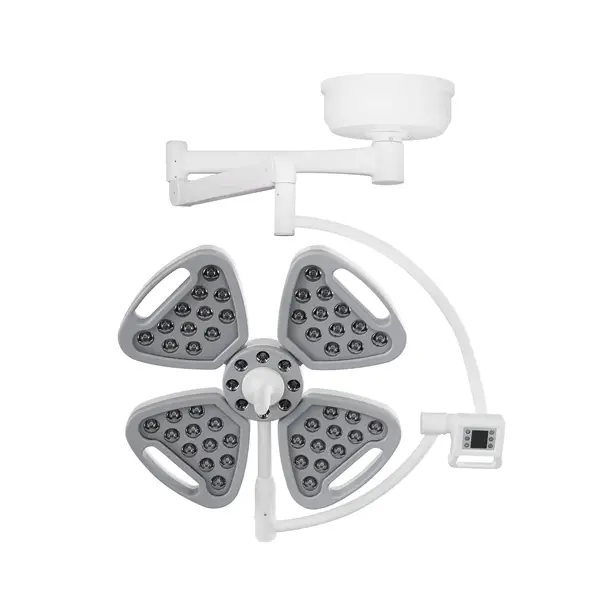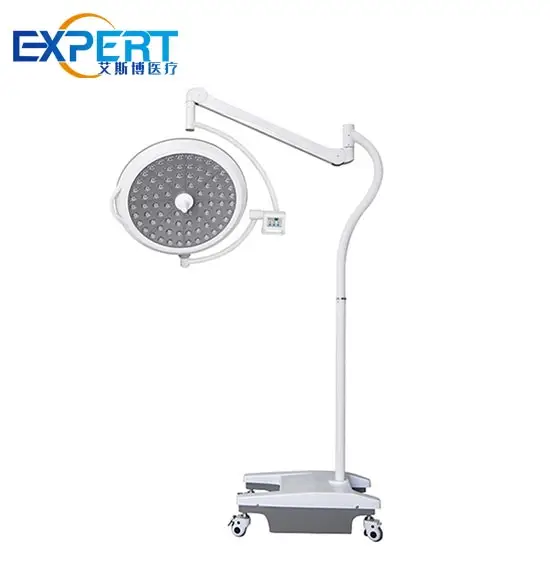Adresse
304, rue Cardinal Nord
Centre Dorchester, MA 02124
Heures de travail
Du lundi au vendredi : 7h - 19h
Week-end : 10h - 17h
Adresse
304, rue Cardinal Nord
Centre Dorchester, MA 02124
Heures de travail
Du lundi au vendredi : 7h - 19h
Week-end : 10h - 17h

Ce guide complet vous aidera à comprendre les aspects clés à prendre en compte lors de la sélection des luminaires chirurgicaux pour votre établissement médical.
Dans les environnements médicaux modernes, les éclairages chirurgicaux jouent un rôle crucial pour garantir aux professionnels de la santé l'éclairage optimal nécessaire à des interventions précises et sûres. Choisir le bon éclairage chirurgical implique de prendre en compte divers facteurs tels que la qualité de l'éclairage, la gestion des ombres, le rendu des couleurs et la facilité d'utilisation. Ce guide complet vous aidera à comprendre les aspects clés à prendre en compte lors du choix d'un éclairage chirurgical pour votre établissement médical.

Les éclairages chirurgicaux sont des systèmes d'éclairage spécialisés conçus pour fournir une lumière intense et focalisée pendant les interventions chirurgicales. Ils sont conçus pour minimiser les ombres, offrir un excellent rendu des couleurs et assurer un éclairage constant, permettant aux chirurgiens et au personnel médical d'effectuer leurs tâches avec précision.
La qualité de l'éclairage au bloc opératoire a un impact direct sur le succès des interventions chirurgicales. Un éclairage chirurgical adapté permet aux chirurgiens de voir clairement, de distinguer les tissus et de réaliser les interventions avec une plus grande précision.
L'un des principaux facteurs à prendre en compte est l'intensité lumineuse. Les éclairages chirurgicaux doivent fournir un éclairage de haute intensité pour garantir un bon éclairage du site chirurgical.
Une répartition uniforme de la lumière est essentielle pour éviter les zones de fort et de faible éclairage, qui peuvent provoquer une fatigue visuelle et des erreurs.
Les luminaires chirurgicaux modernes sont équipés d'une technologie avancée de réduction des ombres pour garantir que le champ chirurgical reste uniformément éclairé même lorsque les mains ou les instruments du chirurgien bloquent une partie de la lumière.
L'indice de rendu des couleurs (IRC) mesure la capacité d'une source lumineuse à reproduire fidèlement les couleurs de divers objets. Les éclairages chirurgicaux doivent avoir un IRC élevé pour garantir un rendu naturel des tissus et des organes, contribuant ainsi à un diagnostic et un traitement précis.
La température de couleur de la lumière, mesurée en Kelvin (K), influence la perception des couleurs. Les éclairages chirurgicaux doivent avoir une température de couleur proche de la lumière naturelle.
La flexibilité d’ajustement de la position et de l’angle des luminaires chirurgicaux est cruciale pour un éclairage optimal lors de différentes procédures.
Des commandes et des interfaces conviviales permettent au personnel médical de régler l’éclairage rapidement et efficacement.
La qualité de fabrication des éclairages chirurgicaux influence leur longévité et leurs performances. Des matériaux et une construction de haute qualité garantissent que les luminaires résistent aux exigences du bloc opératoire.
Tenez compte de la facilité d'entretien et de la disponibilité des pièces de rechange. Les éclairages chirurgicaux doivent être faciles à nettoyer et à entretenir pour garantir leur fonctionnement optimal.

| Caractéristique | Importance | Norme optimale | Impact sur la chirurgie |
|---|---|---|---|
| Intensité lumineuse | Assure un éclairage suffisant | 40 000 à 160 000 lux | Améliore la visibilité et la précision |
| Uniformité | Réduit la fatigue visuelle | Répartition uniforme de la lumière | Empêche les erreurs dues à un éclairage inégal |
| Gestion des ombres | Maintient un éclairage constant | Éclairage multi-sources, adaptabilité | Réduit les ombres, améliore la mise au point |
| Indice de rendu des couleurs | Représentation précise des couleurs | IRC supérieur à 90 | Meilleure différenciation des tissus |
| Température de couleur | Imite la lumière naturelle du jour | 3 500 000 à 4 500 000 | Lumière blanche équilibrée |
| Ajustabilité | Positionnement flexible | Rotation à 360 degrés | Éclairage optimal pour diverses procédures |
| Durabilité | Longévité et performance | Matériaux de haute qualité | Résiste aux exigences de la salle d'opération |
| Entretien | Facile à nettoyer et à entretenir | Surfaces lisses, pièces accessibles | Assure la fiabilité et l'hygiène |
Choisir le meilleur luminaires chirurgicaux Il s'agit de comprendre les facteurs critiques qui influencent leurs performances et leur adéquation à diverses procédures médicales. En mettant l'accent sur la qualité de l'éclairage, la gestion des ombres, le rendu des couleurs, la facilité d'utilisation et la durabilité, vous pouvez sélectionner des luminaires qui améliorent l'efficacité et la sécurité de votre bloc opératoire. Investir dans des éclairages chirurgicaux de haute qualité est un pas vers la réussite des interventions chirurgicales et le maintien d'un niveau de soins élevé dans votre établissement médical.
Les différents types d'éclairages chirurgicaux comprennent les éclairages chirurgicaux à LED, les éclairages chirurgicaux halogènes et les systèmes hybrides. Chaque type offre des avantages distincts en termes d'efficacité énergétique, de qualité d'éclairage et de maintenance.
L'indice de rendu des couleurs (IRC) mesure la précision de la représentation des couleurs sous une source lumineuse. Les éclairages chirurgicaux dotés d'un IRC élevé (supérieur à 90) garantissent un rendu naturel des tissus et des organes, contribuant ainsi à un diagnostic et un traitement précis.
La gestion des ombres est cruciale, car elles peuvent obscurcir le champ opératoire et gêner la visibilité du chirurgien. La technologie avancée de réduction des ombres des éclairages chirurgicaux permet de maintenir un éclairage constant, même lorsque les mains ou les instruments bloquent une partie de la lumière.
L'entretien des éclairages chirurgicaux comprend un nettoyage régulier avec des désinfectants appropriés, la vérification et le remplacement des ampoules ou LED défectueuses, et le bon fonctionnement de toutes les pièces réglables. Un entretien régulier garantit des performances et une longévité optimales des éclairages.
Lors du choix d'un éclairage chirurgical, tenez compte de facteurs tels que l'intensité lumineuse, l'uniformité, la gestion des ombres, l'indice de rendu des couleurs, la température de couleur, la possibilité de réglage, la durabilité et la facilité d'entretien. Ces facteurs vous aideront à choisir des luminaires offrant le meilleur éclairage possible pour les interventions chirurgicales.
Les éclairages chirurgicaux à LED sont généralement préférés aux éclairages halogènes en raison de leur meilleure efficacité énergétique, de leur durée de vie plus longue et de leur meilleure qualité d'éclairage. Les LED génèrent également moins de chaleur, ce qui est plus confortable pour l'équipe chirurgicale et le patient.
L'intensité lumineuse optimale pour les éclairages chirurgicaux se situe généralement entre 40 000 et 160 000 lux. Cette plage garantit un éclairage suffisant pour un travail chirurgical précis et détaillé, améliorant ainsi la visibilité et réduisant les risques d'erreur.
La possibilité de réglage permet de positionner et d'orienter précisément les éclairages chirurgicaux afin d'obtenir un éclairage optimal pour différentes interventions. Des caractéristiques telles que les bras articulés et la rotation à 360 degrés améliorent la flexibilité et garantissent un éclairage optimal du champ opératoire sous différents angles.
Une répartition uniforme de la lumière est importante car elle évite les zones de forte et de faible luminosité, sources de fatigue visuelle et de réduction de la précision des interventions chirurgicales. Un éclairage homogène sur l'ensemble du champ opératoire améliore la visibilité et réduit le risque d'erreurs.
La température de couleur et l'IRC fonctionnent ensemble pour produire un éclairage reproduisant fidèlement la lumière naturelle. Une température de couleur comprise entre 3 500 K et 4 500 K, associée à un IRC élevé (supérieur à 90), garantit un rendu précis des couleurs et un aspect des tissus comparable à celui qu'ils auraient sous la lumière naturelle, contribuant ainsi à la précision des interventions chirurgicales.